Huawei P10 and P10 Plus: Performance & Battery Life Report
by Matt Humrick on May 12, 2017 7:00 AM ESTCPU & System Performance
The P10 and P10 Plus both use the same Kirin 960 SoC from HiSilicon as Huawei’s other flagship phone, the Mate 9. We already looked at Kirin 960’s performance and power efficiency in detail, and we also reviewed the Mate 9 earlier this year, so the two P10’s we’re testing now should not provide many surprises. The only outstanding questions are what type of RAM and NAND our units have, and do the P10s still perform the same as the larger Mate 9?
To evaluate overall system performance, we turn to the PCMark Work 2.0 suite, which tests the combined effects of the CPU, GPU, RAM, and NAND storage. Because it uses standard Android API calls and runs several different real-world workloads that elicit realistic behavior from the CPU governor (unlike synthetic tests that simply run one or more CPUs at max frequency), it’s a good indicator of everyday performance.
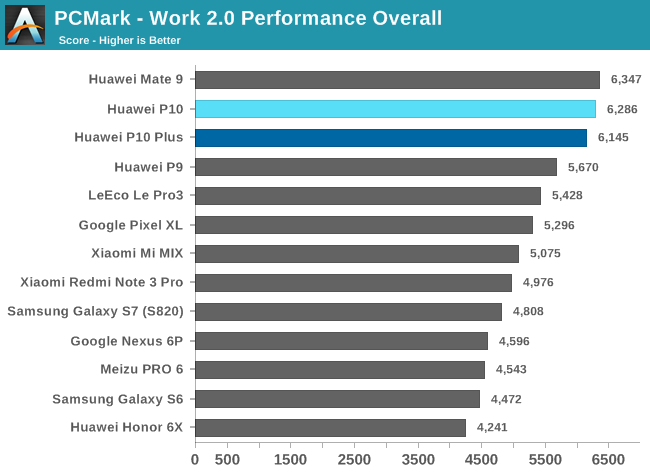
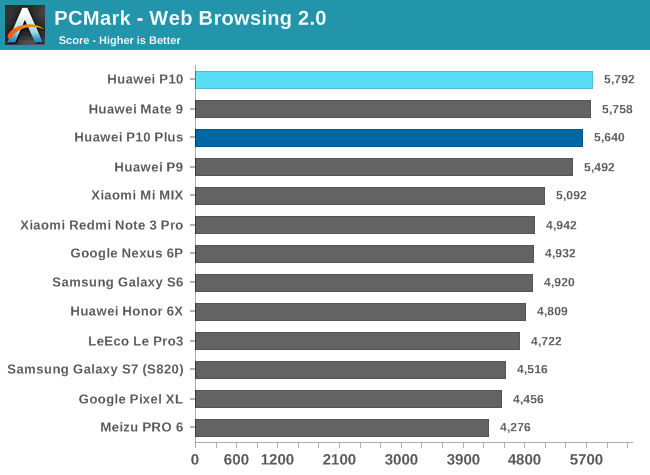
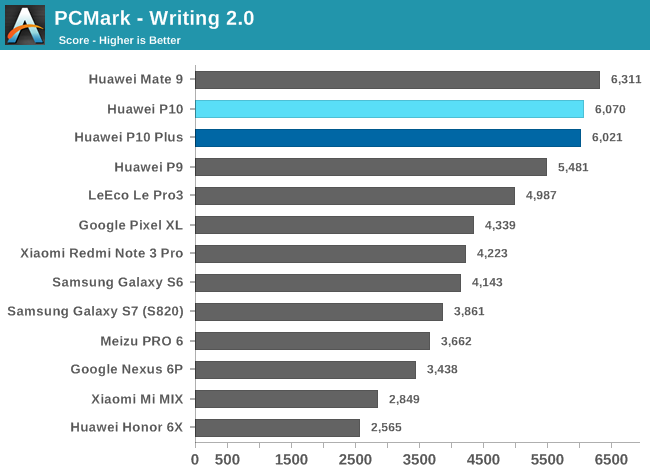
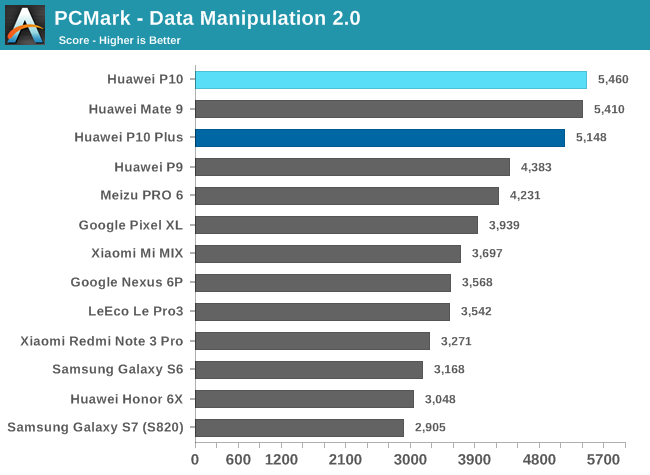
As expected, there’s no significant performance difference between the P10, P10 Plus, and Mate 9 in any of the PCMark Work 2.0 tests. All three phones post excellent results, with the P10 outperforming the older P9 and its Kirin 955 SoC by 11% overall.
There is not much difference between Huawei’s current generation flagships and last year’s P9 and Mate 8 in the Web Browsing test. The P10 Plus holds a slim 11% lead over Xiaomi’s Mi MIX and its Snapdragon 821 SoC, which grows to a more significant 27% lead over the Galaxy S7 and Pixel XL.
The Writing test is characterized by frequent but short bursts of activity that benefit from running on the big CPU cluster. While CPU IPC and frequency are important here, so is the phone’s proclivity to migrate threads onto the big cores. Huawei’s phones perform well once again in this test, with the P10 maintaining its roughly 11% advantage over the P9. There’s significantly more variation among the other phones in the chart, with the Mi MIX landing near the bottom at only half the performance of the P10. The Pixel XL trades places with the MIX in this test, but is still outperformed by the P10 by about 40%.
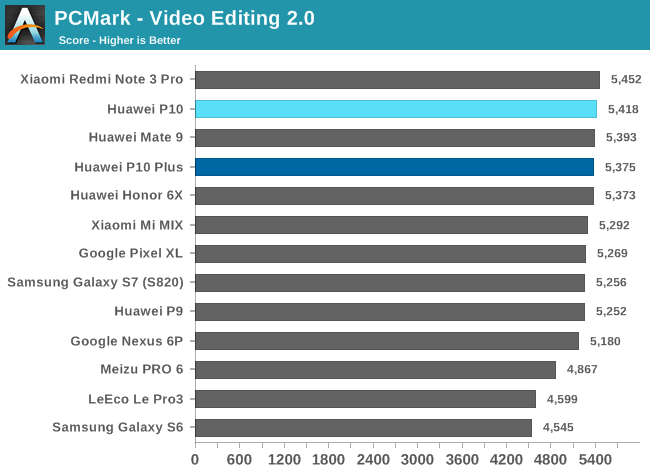
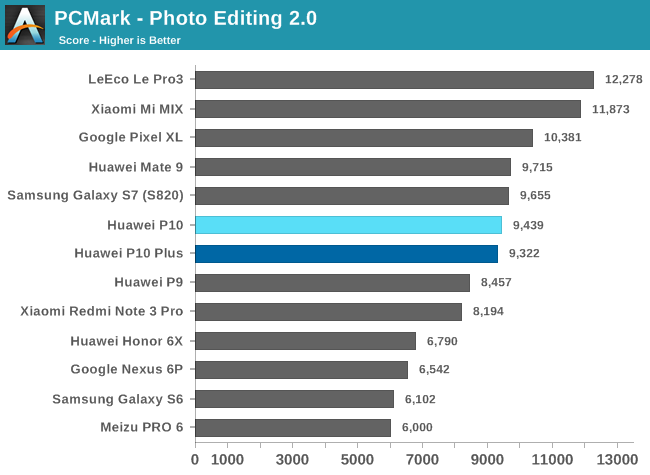
The PCMark Video Editing test is not particularly strenuous, so most phones perform about the same. The Photo Editing test, which uses both the CPU and GPU for applying various photo effects, produces more interesting results. It’s the only PCMark test where Huawei’s phones do not finish on top. Instead, phones using Snapdragon 820/821 SoCs and Qualcomm’s Adreno 530 GPU perform the best when running these workloads. The P10 holds a slim 12% advantage over the P9, but the Snapdragon 821 powered Le Pro3 is 30% faster.
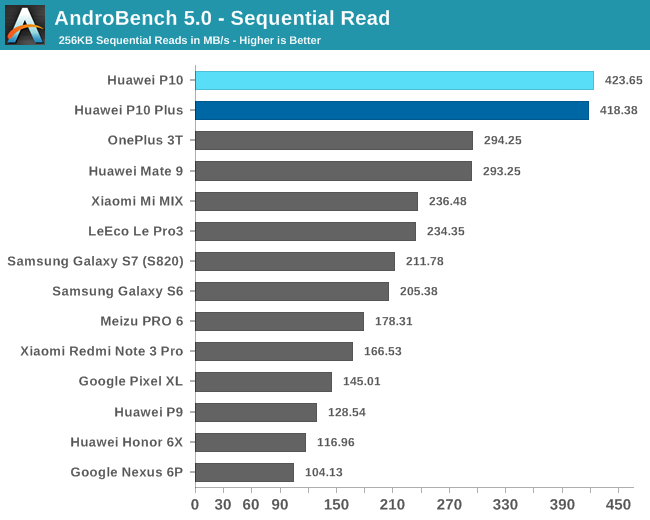
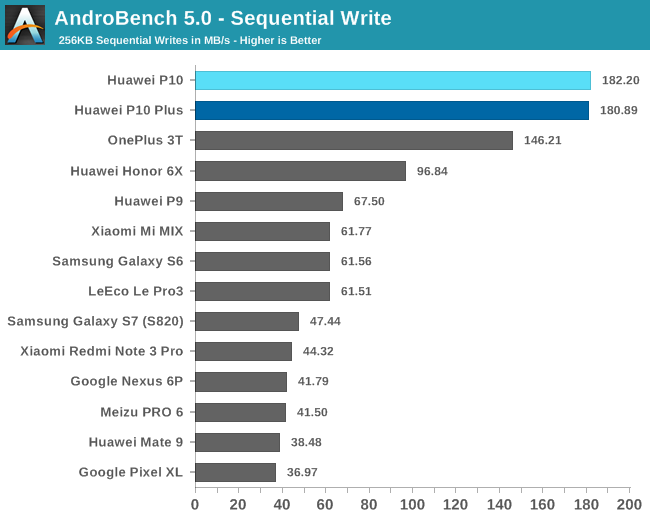
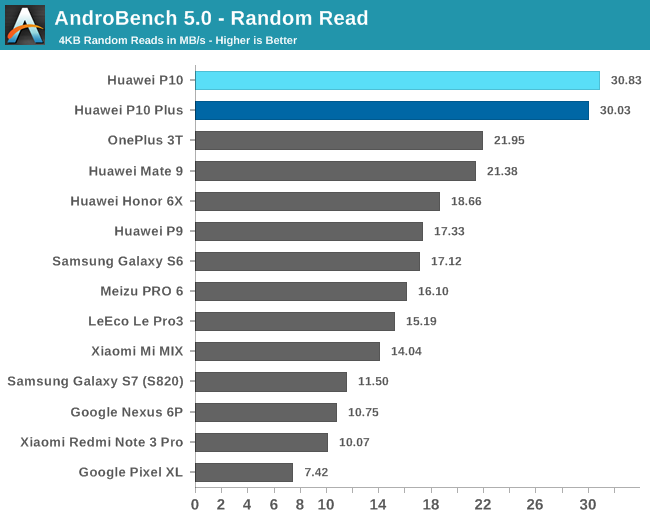
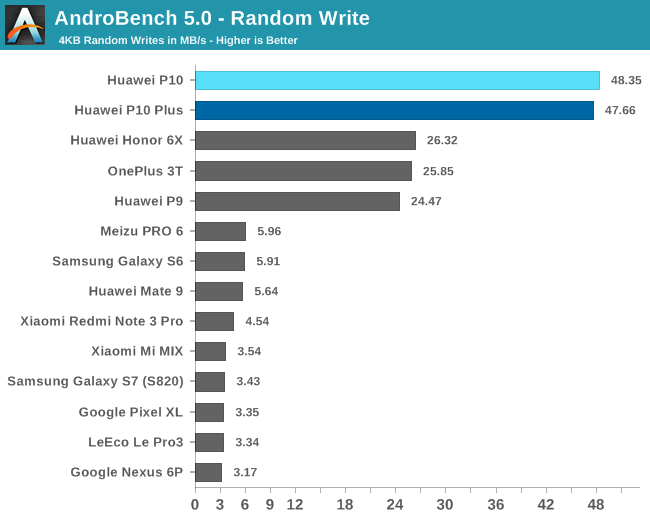
Obviously there is nothing wrong with storage performance for our P10s. Both the P10 and P10 Plus post excellent (and essentially identical) sequential and random throughput values. It’s also worth noting that both units are using UFS 2.0 NAND from Samsung.
The P10s easily outperform the Mate 9, especially when writing data sequentially or randomly. This particular Mate 9 is using UFS 2.0 NAND from Toshiba, which illustrates an important point: Just because a phone uses UFS 2.0 or 2.1 NAND does not mean it will perform well. Storage performance is multi-layered, starting with the operating system kernel and eventually ending at the storage controller and NAND itself. Even the underlying filesystem makes a big difference, with the P10, P10 Plus, P9, Mate 9, and OnePlus 3T all using the better performing F2FS (Flash-Friendly File System) for the /data partition instead of the default EXT4 file system.
With all of these variables in play, it’s impossible to even say that UFS NAND is always faster than eMMC NAND. For example, the Huawei P9, which uses eMMC 5.1 NAND, outperforms the newer Pixel XL and its UFS NAND in all but the sequential read test. The P9 also outperforms the Mate 9 in both writing tests. Now this does not mean a P10 with eMMC 5.1 NAND would perform the same or better than the two UFS examples we tested (it would not be able to match the sequential numbers at least), but it is important to take a step back and see the bigger picture.
| Storage Performance (AndroBench 5.0) | ||||||||
| Seq. Read (KB) |
Seq. Write (KB) |
Random Read (KB) |
Random Write (KB) |
|||||
| 1024 | 2048 | 1024 | 2048 | 8 | 16 | 8 | 16 | |
| Huawei P10 | 499.35 | 541.97 | 185.50 | 185.18 | 55.73 | 96.00 | 84.86 | 139.32 |
| Huawei P10 Plus | 516.78 | 558.45 | 182.24 | 183.15 | 53.22 | 93.37 | 82.52 | 137.51 |
| Huawei Mate 9 | 429.17 | 480.07 | 74.60 | 100.01 | 38.81 | 66.27 | 10.77 | 16.99 |
| Huawei Honor 8 | 169.07 | 198.77 | 83.65 | 102.45 | 30.2 | 46.25 | 17.17 | 26.59 |
The table above shows how storage performance scales with larger IO sizes. While the values we use in our general tests above represent the most common IO sizes, other workloads, notably accessing media files like photos and video, will utilize larger IO transfers, so it’s important to see how a phone performs over a wider range of scenarios. Sequential read throughput for the P10s continues to scale as expected, maintaining their lead over the Mate 9. Sequential write performance does not scale any further and only maintains its already high values. The Honor 8, which uses eMMC 5.1 NAND like the P9, manages to outperform the Mate 9 when writing sequentially or randomly at any IO size.
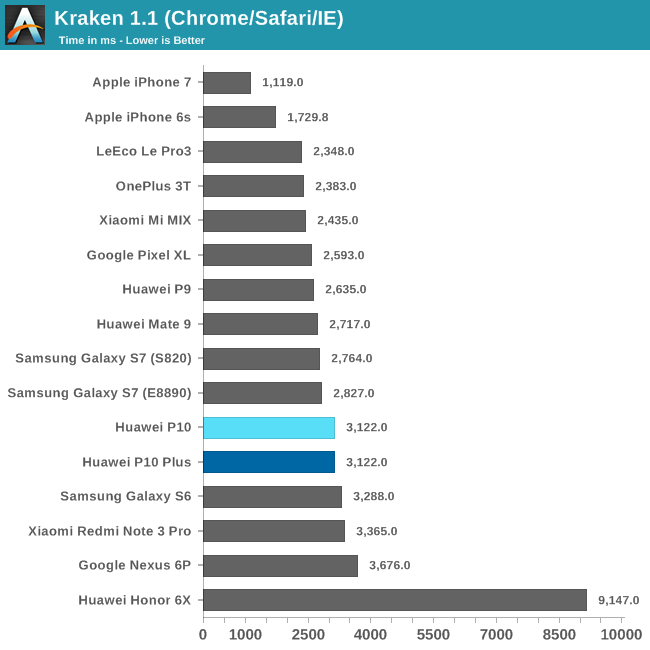
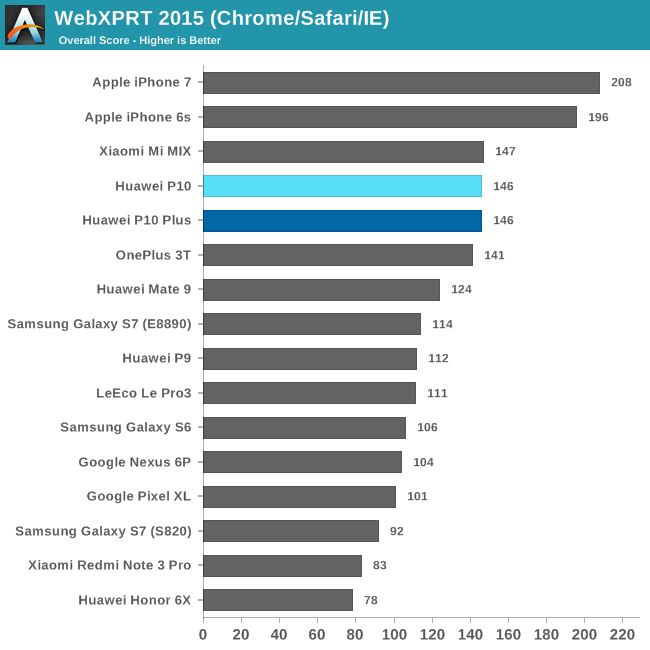
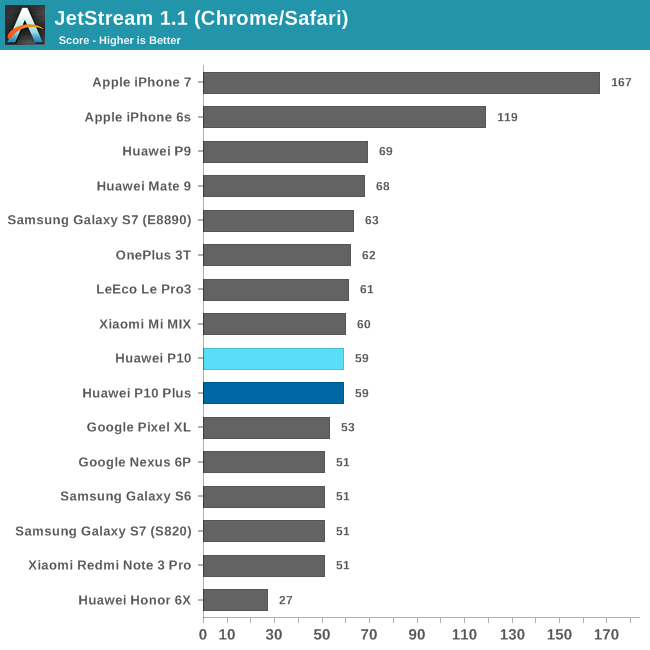
In the Kraken JavaScript test, both P10s fall behind the Mate 9 by 15%. The P10’s A73 CPU cores also cannot match the performance of the higher frequency A72s in the P9’s Kirin 955 SoC, or the custom Kryo cores in the Snapdragon 820/821 devices. The P10s do outperform the less-expensive Honor 6X by a factor of three, highlighting the performance deficit of using octa-core A53 CPU configurations instead of pairing the A53 cluster with 2-4 big out-of-order CPU cores.
Finishing positions flip in WebXPRT 2015, with the P10s out in front of the Mate 9 by 18% and the P9 by 30%. Scores in JetStream show less variation, but the P10s fall behind the Mate 9 and P9 once again by 17%.
The tests above corroborate my own subjective experience with the P10: It’s fast. Common tasks such as installing or opening apps, switching between running apps, and searching through my email inbox complete quickly. The redesigned EMUI 5.1 UI is smooth and responsive—not Pixel XL smooth, but flagship smooth.










74 Comments
View All Comments
Matt Humrick - Saturday, May 13, 2017 - link
"At the very least either you or your should add caveat emptor or YMMV, in BIG BOLD letters to the end of the review. The reputation of anandtech.com deserves at least that."It was discussed at the beginning, middle, and end, so I think it was covered well.
"What is the point of the review if the system YOU purchase could have memory a generation behind, storage 2 generations behind, and a different bin of processor?"
This report shows several things:
1) Not all P10s come with alternate memory components
2) It shows what perf/battery life can be when not using the alternate components
3) It discusses the P10 multi-sourcing issue and how it may impact perf/battery life
4) It shows that the type of NAND alone is not enough to predict storage performance
Basically, we want to provide as much info as we can so our readers can make an informed buying decision. Obviously, I would have liked to get a P10 with the alternate components for comparison, but that was not possible.
drajitshnew - Saturday, May 13, 2017 - link
I said "COULD". you admit admit that GOLDEN SAMPLES are a possibilityYou must admit that with a still lower binned SoC, eMMC instead of UHS, DDR3 instead of DDR4, the benchmarks could be materially different.
Matt Humrick - Saturday, May 13, 2017 - link
Yes, that's what I said in the article.AlphaBlaster - Sunday, May 14, 2017 - link
Unless you are chinese, but even then it does not make sense, why exactly do you want Huawei to succeed in the western market? It is a corrupted organization managed by government, the reason why their networking hardware is on a ban list in many EU organizations is because of repeated and consistent backdoors implemented in the hardware and software (Not that Cisco and others wouldn't do that, but there is a difference between giving access to FBI and giving it to your industry competitor). I worked for the czech branch for couple of years on various projects and it was a horrible experience, they did not even try to hide that most of their large contracts - they got pretty big deals to provide LTE hardware for carriers, was obtained via bribes. There is absolutely no reason to be giddy about Huawei growing exponentially.John Other - Sunday, May 14, 2017 - link
I was with the people who are horrified by the principle of the idea of components substitution, at first.At least on a flagship.
At least on a product that will sell a lot on specification given the lower rank of the brand in public consciousness.
I think only the final of those three arguments actually counts.
I made a living, once, selling home assembly hifi designs, and so I know that component substitution is both necessary, and a difficult decision for the vendor relationship with customers.
This substitution news broke right at the moment I had to decide on the purchase.
I went ahead, confident that I can return the goods since this is 2017 (or 1997, we've had excellent consumer laws for a long time, providing you avoid silly supplier risks) and can only report I am a happy customer.
And I do not even know what components my P10 contains.
I decided that I would use the phone first, and only after 2 weeks I have to return the device under distance selling law (EU) will I review and if necessary check the components installed.
I almost want to report I have the lesser components, to assuage the furore, because I just doubt that real world impact will manifest unless there is psychological confirmation bias at work.
To criticise a review is maybe a bit much, however the review could make more out of the entire process of decisions that are involved in, and surround, components substitution.
WPX00 - Friday, May 12, 2017 - link
Company can't make enough of something because parts are short, ala Pixel? Customers complain.Company makes more of something with alternative parts, like this? Customers complain.
At the end of the day, the fact of the matter is, supply is hard. Even Samsung can't get enough UFS parts. And Samsung MANUFACTURES these things. What makes you think Huawei can? They have to launch a flagship no matter what.
Meteor2 - Saturday, May 13, 2017 - link
Nobody says it's easy. We're paying them to get it right.I find this shocking; I was warming to Huwei, they make nice SoCs, but this is appalling.
BrokenCrayons - Monday, May 15, 2017 - link
Notably, I would suspect that customers probably aren't complaining. Of the group of us commenting in these articles, I would be willing to bet few to none of us actually bought a P10 or will ever do so.s.yu - Saturday, July 29, 2017 - link
They can sell it high-low specced with the same chassis and different prices. The matter is not whether or not they use different parts but whether or not they were forthcoming and honest about it. They were first deceptive then brazen and unapologetic (and further lied) when word got out.Elsote - Friday, May 12, 2017 - link
Until when will we see A53 cpus in flagship phones?